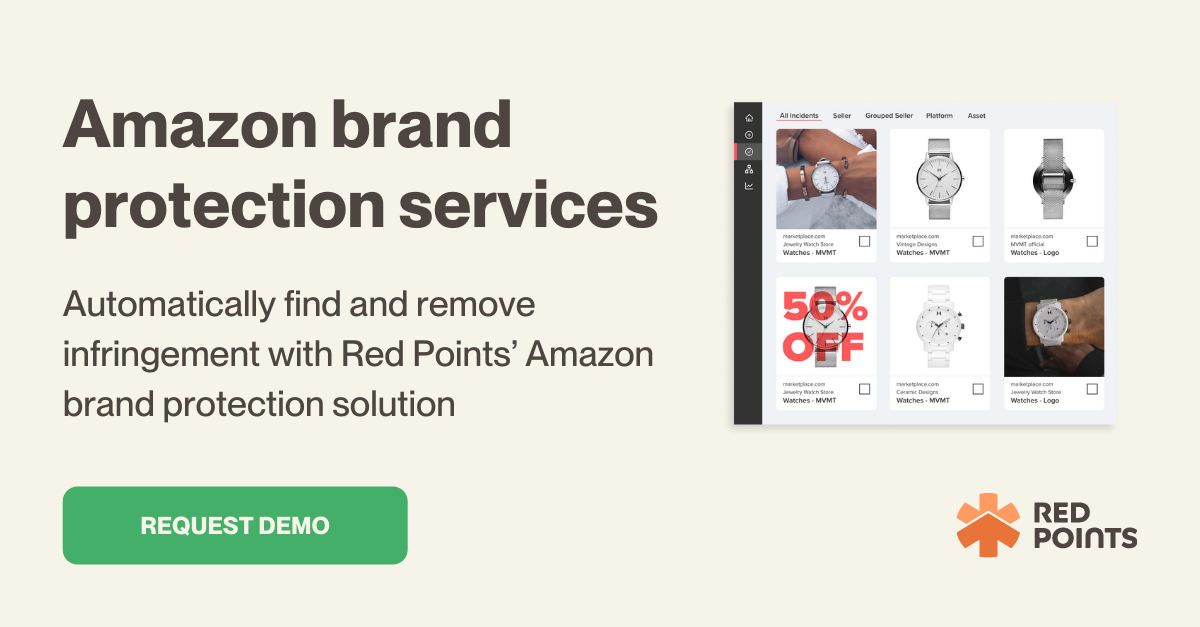Many brands are struggling with infringing sellers on Amazon that threaten their profit margins and brand reputation. Research shows that about 55% percent of sold units on Amazon come from third-party sellers. Even if your brand is not selling on Amazon, there is still the chance that someone is selling your products or its counterfeits on the platform.
In this article, we will discuss attacks that brands are facing on Amazon and the most trusted ways to protect your brand on Amazon. You will learn how to deal with unauthorized sellers, IP infringements, MAP violations and fake reviews.
Summary:
- Get a full picture of the most common attacks on Amazon
- Learn how to apply Amazon features to protect your brand
- Find out how technology-based brand protection can help you to efficiently safeguard your brand on Amazon
Types of attacks on Amazon
Before we go into the details on how to protect your brand on Amazon, let’s first look at the most common threats brands are facing.
Listing Hijacking & Piggybacking
Winning the Amazon Buy Box is a key goal for most sellers on Amazon as it dictates which products are first shown to customers. However, there are two types of third-party sellers, namely hijackers and piggybackers, that might take the Buy Box off your products.
Listing hijacking refers to the sale of counterfeits of one or more of your products that are very similar but don’t pretend to be your brand. Hijackers usually take your listing by copying the universal product code (UPC) of your product and using it to place their products.
Piggybackers, on the contrary, are nothing but resellers that sell your genuine products against your will. Those resellers often get their hands on your products legally for example when they find your items at a big discount somewhere else. The problem with piggybackers is that, in principle, anyone can sell products on Amazon as far as they have been legally acquired.
Intellectual property infringement
IP infringements are one of the biggest problems brands are facing on Amazon. The platform is well aware of the issue and provides information on measures in its IP Policy for Sellers. Let’s first break down the different types of IP infringements on Amazon in order to know what to keep an eye on.
Copyright infringement on Amazon
Copyrights protect the original works of a creator and unlike patents or trademarks, your work is automatically protected by copyright law as soon as you publish it. As such, your Amazon product description, photos, and the design of your packaging might be copyright protected. In turn, anyone who uses or copies those works without your permission is infringing on your copyrights.
Trademark infringement on Amazon
Trademarks protect brand-defining elements like names, phrases logos, color schemes, and others. Trademarks need to be registered in order to be fully effective. Stopping someone from using your brand name or logo will be way easier with a registered trademark as it gives you proof of ownership. You can also expect better support from Amazon for enforcing registered trademarks.
Patent infringement on Amazon
Patents are designed to protect inventions and to prevent them from being created, sold, or used on Amazon by any third party without permission. There are two types of patents, namely design patents that protect the appearance of an item and utility patents that cover the functional aspects of an item. Patents are difficult to enforce as the originality of an invention might be contested between parties and Amazon tends to keep out of patent infringement cases.
Fake reviews
Reviews play an important role in consumer behavior as they are a form of social proof. Fake Amazon reviews jeopardize this function and threaten both consumers and brands. Products listed on Amazon often have hundreds or thousands of reviews but many of them appear to be fake.
The platform giant is in an ongoing battle against fake reviews, stating that it analyzes over 10 million review submissions weekly. But still, there are many individuals who have an incentive to generate fake reviews and the reason behind it is simple, they profit from it.
An overly negative fake one-star review can be a malicious attempt from a competitor to sabotage your brand. Fake 5-star reviews on the other hand are used to promote knock-off products of your brand which can hurt your business similarly. Customers who purchase counterfeits of your brand, who have been misled by fake reviews, may falsely blame your brand for the low-quality product which damages your brand reputation as a result.
Unauthorized sellers
Being a successful seller on Amazon is great, however, it might also attract unauthorized sellers that create their own listings offering your products without your permission. They do so by creating fake names or multiple accounts, selling products at significantly lower prices to attract customers.
One technique of unauthorized sellers on Amazon is to offer the original products of a brand which leads to sales losses for brands and legitimate resellers. The second option is to sell counterfeit products that additionally damage the reputation of brands and authorized sellers.
The problem of unauthorized sellers squeezing profit margins for brands made large brands including Birkenstock and Nike to decide not to sell on Amazon anymore. The good news is that there are effective ways to protect your brand on Amazon which we will discuss in the second part of this article.
MAP policy violation
Minimum Advertised Pricing (MAP), is an agreement between manufacturers, distributors, and retailers that ensures that an item can not be advertised below a minimum price. It means that your products will be offered in the same price range across marketplaces to prevent price wars and the devaluation of a brand. However MAP policies are intended to benefit both manufacturers and retailers, brands often face MAP violation on Amazon.
Why do sellers violate MAP policies on Amazon?
First, Amazon is a marketplace where anyone can sell items as long as they have been acquired legally. That opens the door for sellers who sell products from multiple brands, sometimes without the authorization of the manufacturer. Those unauthorized sellers have no ties to the original brand and therefore no reason to follow a brand’s MAP policy.
Second, the above-mentioned goal for all sellers to win the Amazon Buy Box leads to MAP violations. The Buy Box algorithm favors sellers with top ratings and competitive pricing which incentivizes sellers to offer products at a lower price than the competition does. As there are often numerous sellers offering the same product, some sellers go below the MAP price in order to win the Buy Box even if they are undercutting their own margin.
It is important to know that Amazon neither displays MAP pricing on product listings nor does it enforce MAP policies. Amazon is a customer focussed marketplace and takes no action against resellers that violate MAP policies established by manufacturers. Therefore it is up to you to enforce your MAP policy on Amazon and we will show you further down below how to do it.
Top ways to protect your brand on Amazon
Sign up for Amazon Brand Registry
Amazon Brand Registry is a program that helps you protect your brand on Amazon and take better control over your products and IP. The service enables brands to give the platform more information on their products and IP so that both brands and Amazon are better positioned to protect against violations.
Amazon Transparency
Amazon Transparency is a service that is designed to prevent counterfeits from reaching customers. It does so by serializing individual items and scanning them before shipment. The idea is that only authentic products are shipped after scanning the codes of each transparency-enabled product.
Amazon IP Accelerator
Additionally, you can use the Amazon Intellectual Property (IP) Accelerator which helps you to register your IP rights by connecting your business with a network of IP law firms. The program also provides brand protection features that safeguard your brand on Amazon before your IP is officially registered.
Register your intellectual property
Registering your IP is an important step for protecting your brand on Amazon. Thereby you can prove and claim that you are the IP owner when detecting counterfeits or infringements. Having your IP registered also gives you better legal protection in case you need to bring your case to court.
You don’t need a trademark to sell on Amazon, however if you want to enroll in Amazon Brand Registry, you need to have a registered trademark in order to apply.
Report listings to Amazon
Amazon uses ASIN (Amazon Style Identification Number) to group products. Behind an ASIN are usually multiple sellers, including unauthorized sellers, selling the same products. If you want to take down those third-party sellers offering your products at lower prices, taking down the ASIN is not a good option. This would mean that you take down your own listing too.
What you can do is remove those unauthorized sellers from Amazon. You can stop third-party sellers from selling your products from Amazon by reporting them on your Brand Registry page. There, you‘ll have to provide information on the violation you detected.
Amazon will take down sellers that either violate IP rights or the platform’s seller policies. Therefore, it is recommended to register your IP and explain in what sense the seller violated the policies.
Enforce your MAP policy
As mentioned above, MAP policies intend to benefit both manufacturers and retailers because they assure the retailers’ margin and prevent the devaluation of a brand. We have discussed though, that MAP policies get violated on Amazon regardless. However, it is better to have MAP pricing in place than letting resellers offer your products at discount prices that damage your brand perception.
More importantly, you should have an enforcement scheme that protects your MAP policy:
Notify non-compliant sellers
Monitoring the prices set by your seller network is essential to be able to act quickly in case of violations. While it is easy to contact your authorized sellers, it can be challenging to find the contact information of unauthorized sellers that market your products. You can try to find information on unknown sellers elsewhere on the internet like an own website of the seller or listings on other marketplaces.
If you can’t find any contact information of non-compliant sellers, you can purchase a product from them and try to trace them back through the shipping information.
After identifying sellers that violate your MAP policy, you should notify them quickly about the violation and possible consequences in case they don’t comply. Be polite and ask for adjusting their pricing immediately. You can also send a cease-and-desist letter if they don’t fix the prices within a given timeframe.
If a seller does not respond or act upon your message, you can withdraw his or her authorized seller status or take legal action.
Sell your products directly to consumers
If you feel that working with resellers on Amazon causes you more problems because of frequent MAP violations than it benefits you, then you may consider selling your products directly to customers on Amazon.
Of course, being in charge of shipment and customer support requires that you dedicate a lot of resources including storage facilities. On the other hand, it gives you the benefit of having full control over pricing, distribution and communication with customers. It also increases the potential profits you can make from your products.
Become an Amazon vendor
Instead of using Amazon as a marketplace to sell directly to your customers, you become an Amazon vendor which means that you sell your products to Amazon who will then sell them to buyers. Amazon will take care of shipment and customer contact. It is a relatively easy business model as you only deal with Amazon as a purchaser while still benefiting from its market coverage.
While being an Amazon vendor has the potential to increase your sales, a downside is that you are giving up control over your pricing and customer support.
Get in touch with Amazon
If you have already tried your best to fight off an attack on Amazon or settle an issue with a non-compliant seller, you can contact Amazon and ask for help. The platform has a team that is dedicated to infringement cases.
When you send a message, explain the issue you are facing as well as the actions you have taken so far. It helps to emphasize that protecting your brand also helps to protect Amazon’s brand interests as customers expect high levels of product quality and support. It is also helpful to point out which rules and policies have been violated by sellers or counterfeiters. Lastly, be clear about what you want from Amazon to help you protect your brand.
Monitor listings on Amazon
Monitoring your listings efficiently is key for your brand protection on Amazon. Otherwise, counterfeits, IP infringements and fake reviews might damage your brand without your knowledge.
As the enormous amount of sellers on Amazon makes it difficult, if not impossible to monitor listings manually, getting professional help to do so is recommended. Brand protection services like Red Points can detect IP infringements Amazon around the clock with technology-based solutions.
Take control of fake reviews
Controlling fake reviews on Amazon starts with assessing whether a review is fake or not. Here are some indicators to look out for:
- The proportion of positive and negative reviews. If the bulk of reviews are positive but a third are 1-star reviews, that should make you skeptical.
- A bulk of reviews are written in broken English
- The review is overly positive or negative without giving specific information on the product
- The reviewers account only exists for a few days but has posted a vast number of reviews already
There are also third-party sites like fakespot.com which can help you detect fake reviews on Amazon automatically.
What’s next
Here are the main takeaways from what we have learned in this article:
- Amazon is a marketplace where anyone can sell anything as long as it is acquired legally. Therefore, you have to protect your brand from unauthorized sellers on Amazon.
- Registering your IP and monitoring listings and reviews is essential to protecting your brand on Amazon.
- Get help from Amazon brand protection services like Red Points to detect and takedown infringements.
Red Points Amazon brand protection services help safeguard your brand from infringements around the clock. Reach out to us today to request a demo.






